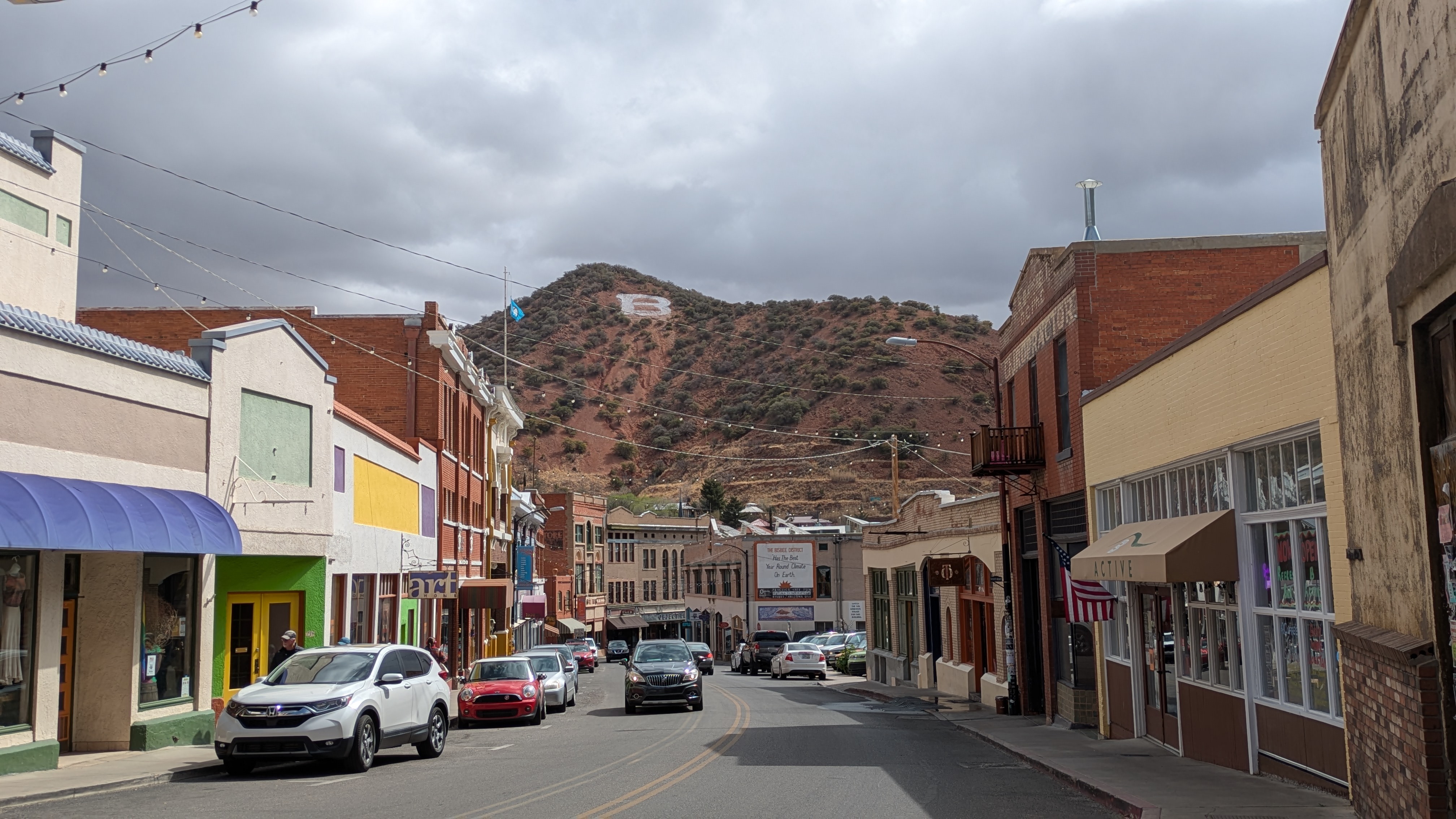
Twenty years of married bliss called for a fitting celebration. By our wont, Linda and I sought historical accommodations in which to spend the night, a custom originating from our first honeymoon. We had for a while intended to check out Bisbee, Arizona, so this was the perfect opportunity. I booked a room in the 1902 Copper Queen Hotel.
Thursday, April 3: With myself in the driver’s seat, our RAV4 zoomed away from Silver City southwestward on State Highway 90 around 11:00 a.m. We love this scenic stretch of road, which skirts the Burro Mountains and rolls through a precious bit of Gila National Forest. After a brief pause at Lordsburg, we steered west along the superslab known as Interstate 10. Soon we crossed the Animas Valley and its Lordsburg Playa. The bright-white surface indicates millennia of mineral accumulation drained from surrounding elevations, which left water no way out save by evaporation.
As the signal from our favorite local radio station turned to static, I switched on a couple of my music collections to fit the trip’s theme: Miscellaneous Love Songs and God Weds Goddess, both party soundtracks from the 1980s. Who could resist Frank Sinatra’s “Love and Marriage”? You can’t have one without the other!
At Road Forks, we turned south on New Mexico 80, which parallels the Arizona state line until the town of Rodeo, where we crossed into the Grand Canyon State and set our clocks back one hour. The road here became Arizona 80, numbered in homage to old US Highway 80, a major east-west thoroughfare nearly as important as Route 66.
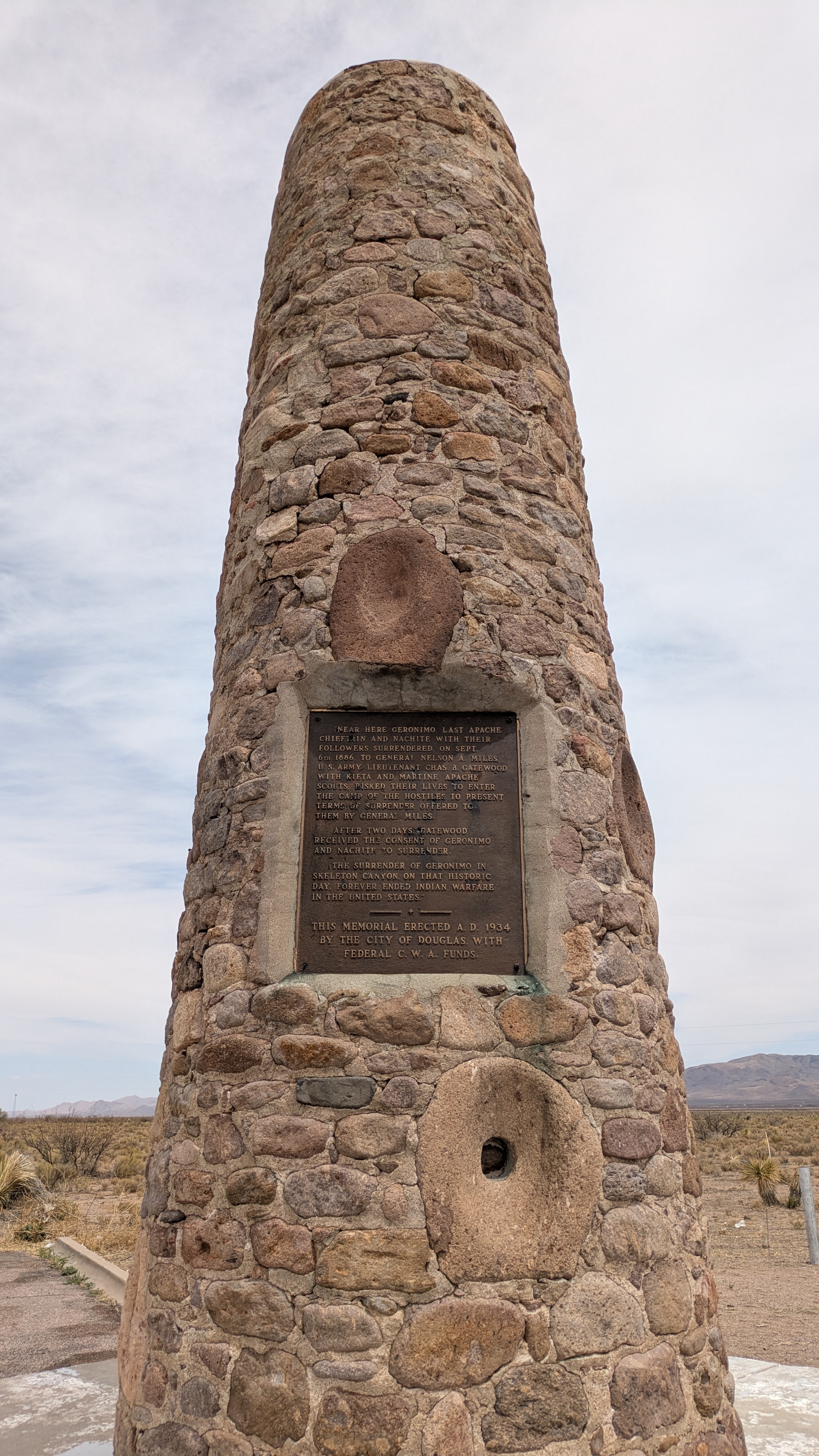
A few miles in, at 12:15 p.m., Mountain Standard Time, we enjoyed a snack lunch next to Geronimo’s surrender monument, which resembled a fire hose nozzle or Irish round tower. With that Apache chief’s capitulation in 1886, major Indian wars ceased, and Anglo-Americans rapidly began to develop the southern Arizona territory. Linda took the wheel while I caught a few winks.
I awakened in Douglas, which sports a well-stocked visitor center with helpful, enthusiastic staff. We came away with fists full of brochures about that locale and what lay ahead.
We hugged the Mexico border for a few miles, curved northwest, then ascended southwest through a gap into the Mule Mountains. Soon we caught our first glimpse of the industry that brought Bisbee into existence: mine tailings towered on both sides of the highway, and a gigantic pit lay just over the edge.
Historic Bisbee itself parallels a narrow drainage known a Tombstone Canyon, a name that evokes real or imagined memories of Wild West gunfighters, saloons, and lawmen. But a different activity here brought a much bigger economic impact than six-shooters and sheriffs. With Native Americans dispatched and railroads built, widespread telephones and electric power increased the market for copper, which proved abundant here. Mining attracted workers and their families between 1880 and 1975 to dig first gold, silver, and molybdenum, then the indispensable red metal.
We located the venerable Copper Queen Hotel, checked in, and climbed three wooden flights to settle in Room 314. Of modest size, the chamber came with a dresser, side table, full-size bed, TV, and roomy bathroom with a claw-foot tub and shower.
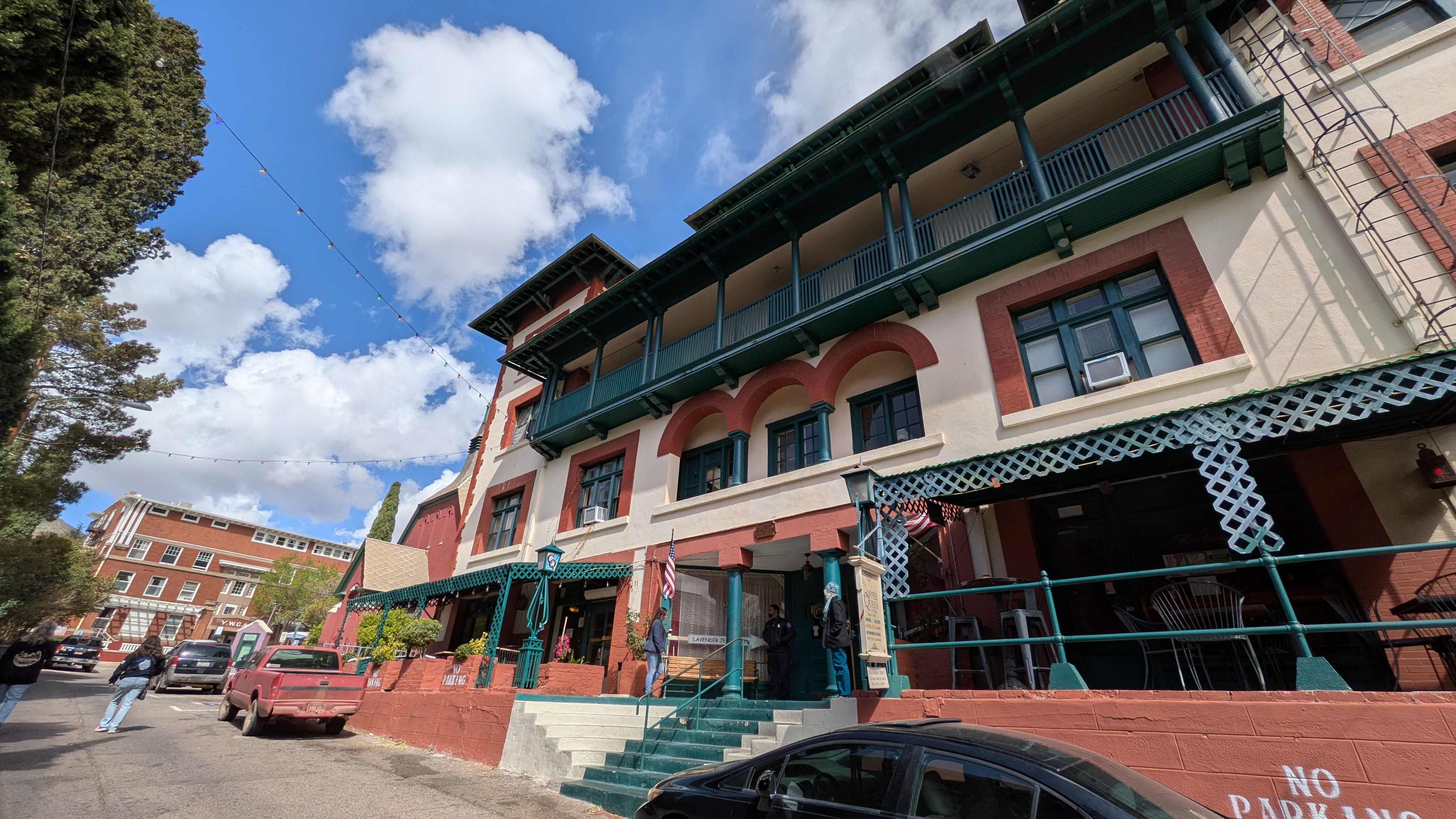
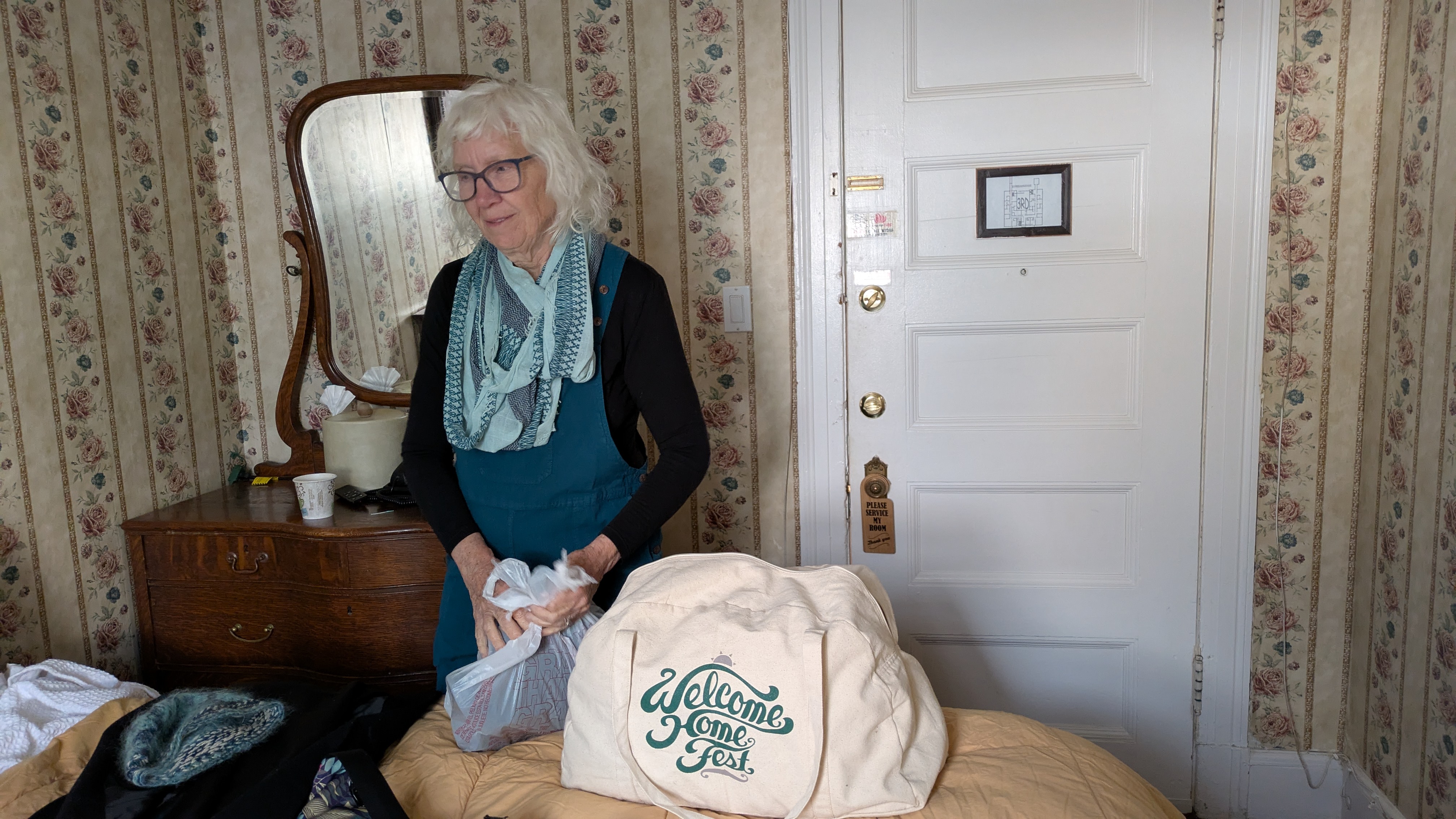
xxxxxxxxxxxxxxxxxxxxxxxxxxxxxxxxxxxxxxxxxxxxxxxxxxxxxxxxxxxxxxxxxxxxxxxxxxxxxxxxxxxxxxxxxxxxxxxxxxxxxxxxxxxxxxxxxxOut, we strolled across Main Street to a miniature mall where we found a well-equipped book store, where I purchased an arty pictorial map of the village. Alas, the free Discover Bisbee brochure and chart proved a puzzle to use: It lists attractions alphabetically; streets come color-coded; circled numbers refer to addresses. I didn’t figure out this scheme until after we returned home, but felt grateful for the info and graphics.
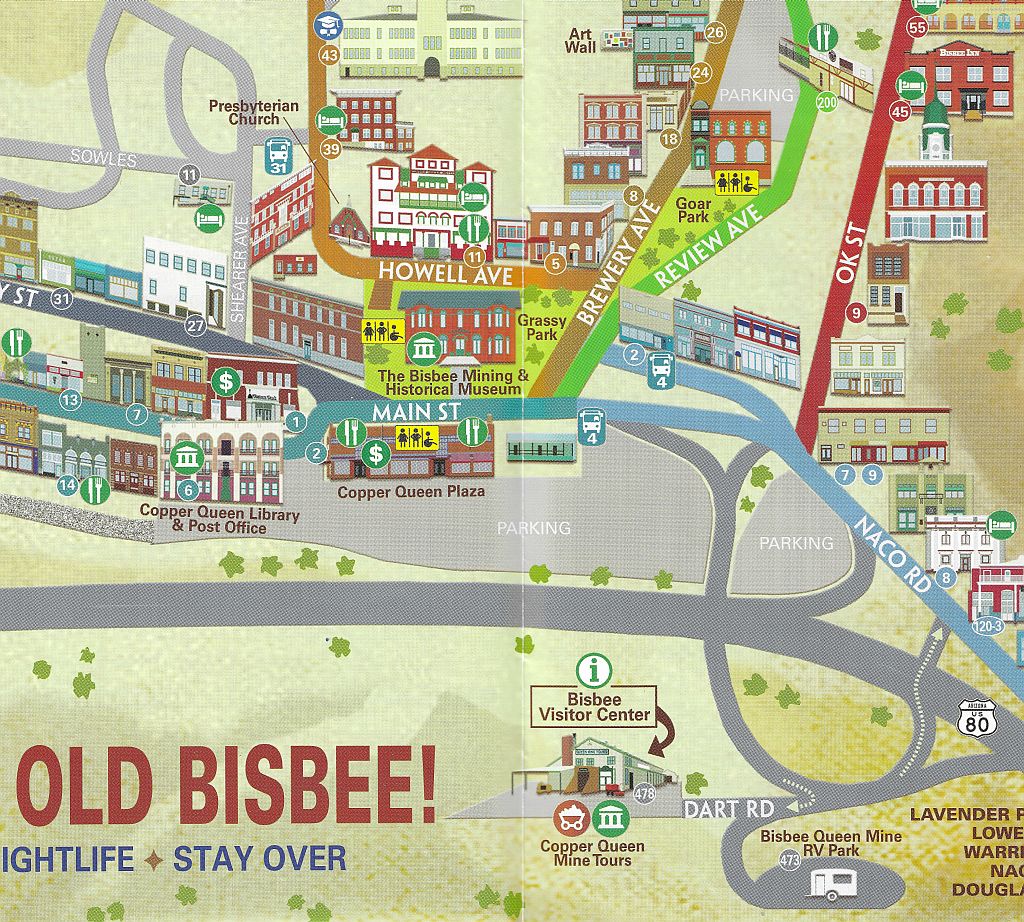
Nearby sat Bisbee Coffee, which would prove important next morning.
The principle thoroughfare consists of tangent two- and three-floor storefronts lined up along a serpentine way. To me it felt super-urban, an imposing Gilded Age American city in miniature. We couldn’t believe the number of hotels—14. The town’s steep topography and the ubiquity of steps give rise to the Bisbee 1000 Annual Great Stair Climb in October. Our path took us as far as the landmark Castle Rock before we reversed course.
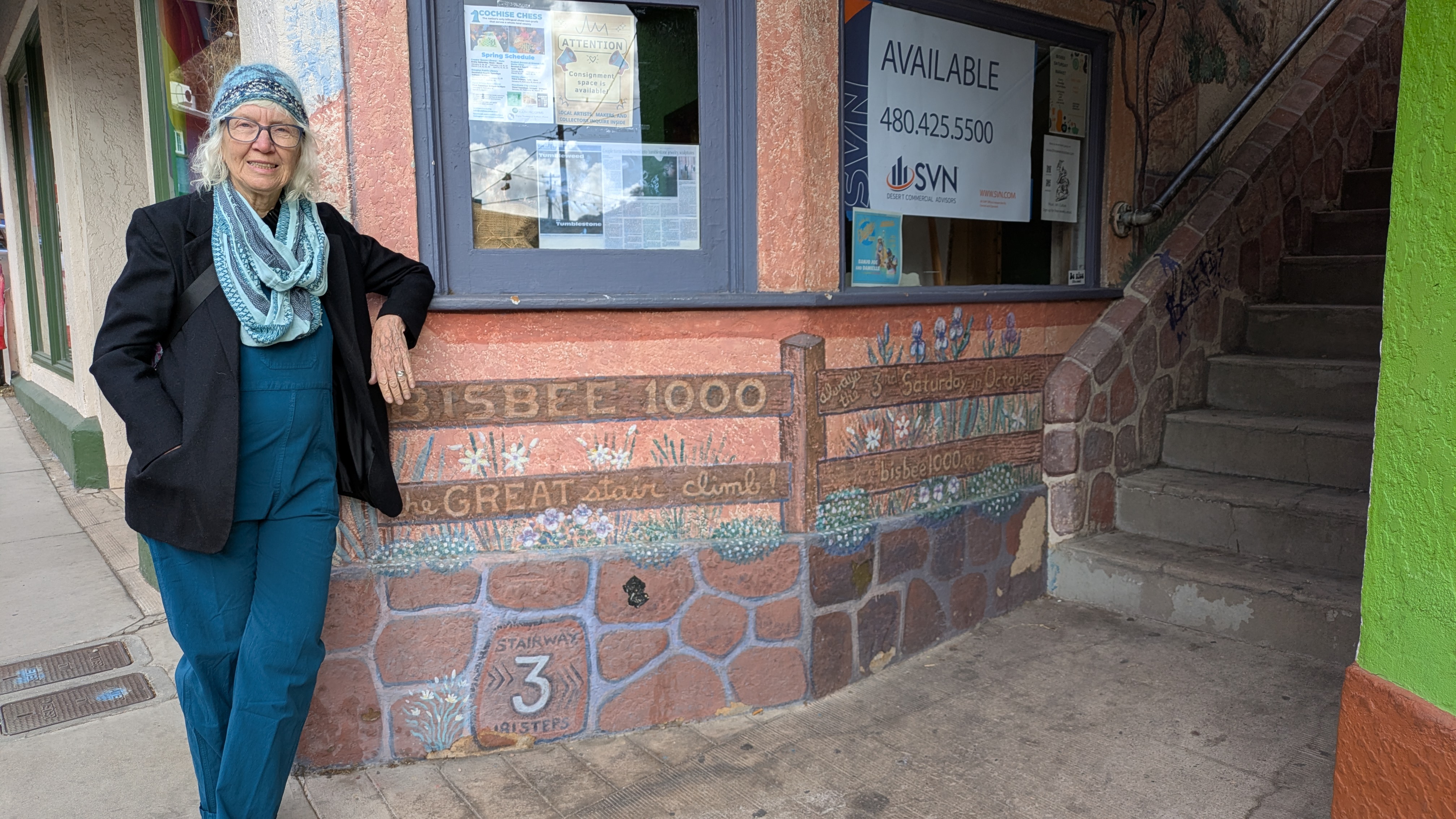

Partway up Brewer Gulch, Bisbee Brewing and Distillery brought out their regional gin plus a taster tray of ales and lagers. All pleased.
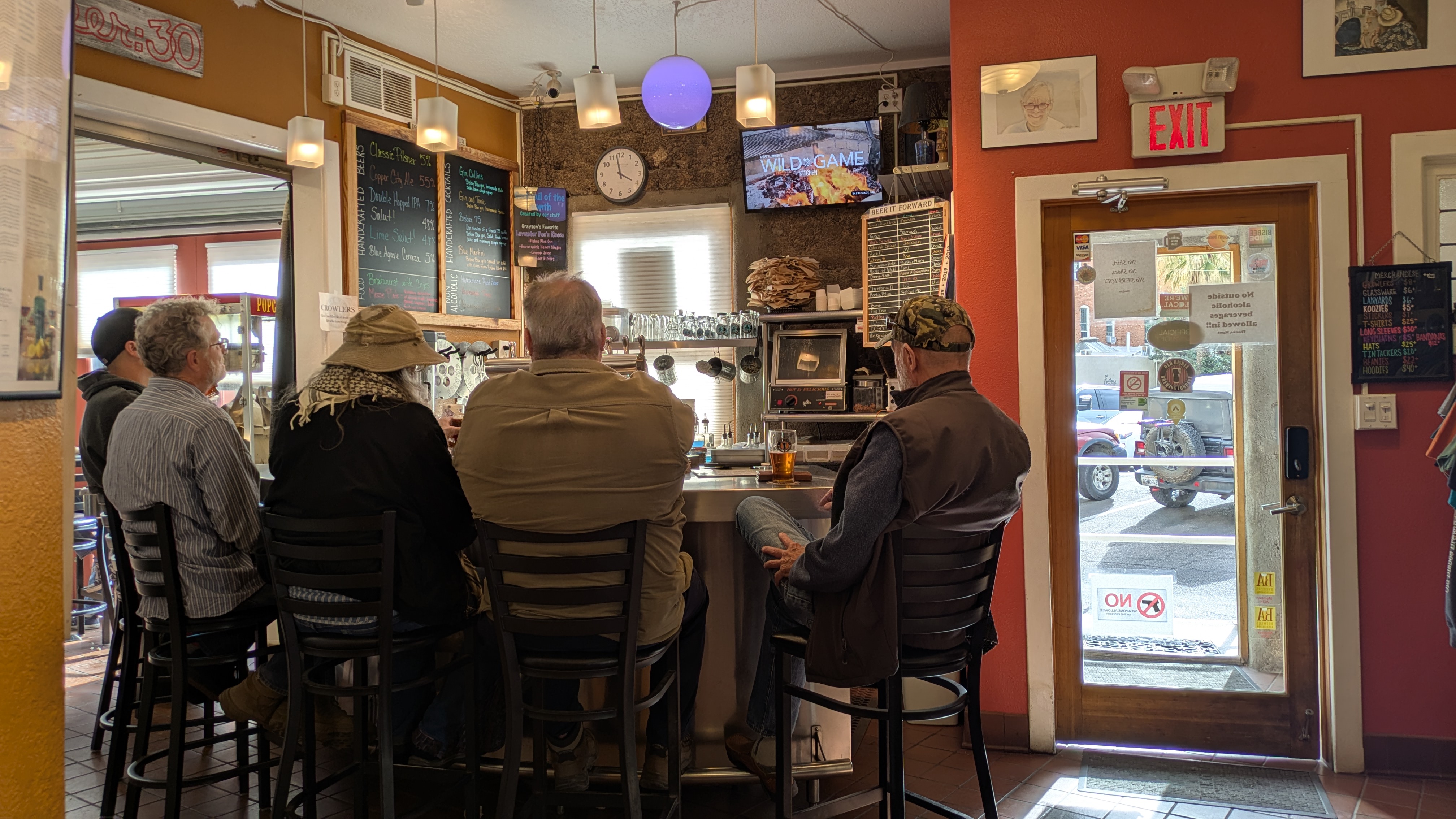
Contented, we floated out into the late afternoon and sought an early dinner. Handily, the hotel’s own white-tablecloth 1902 Spirit Room restaurant opened at 4:30. We sat near a sunset window.
From the menu we chose a stuffed portobello mushroom cap and New York Strip with sides of caramelized onions, zucchini, spinach, mozzarella, baked potato, Brussels sprouts, veggie medley. I washed down my repast with a refreshing Blue Moon.
Back upstairs, we relaxed with full bellies and attempted to plan the rest of our stay. Too many options! We succumbed instead to the temptations of television and watched The Mauritanian, a 2021 legal drama film based on the memoir of Mohamedou O. Slahi, a North African man who was held without charge from 2002 to 2016 in Gitmo. For more than two hours, we witnessed detention, deception, and distress. The story seemed way too real, considering our current political situation. It wasn’t the romantic mood we’d sought. Glad for sleep, though. We perceived not one ghost in the legendarily haunted building.
Friday, April 4: Woke up refreshed and ready for another day of sightseeing. Somehow missed eating early in the hotel, so we crossed the main drag to Bisbee Coffee. That establishment served me an “everything” breakfast bagel with egg, cheese, and bacon. Linda enjoyed a crispy rice treat. Both relished hot beverages: Chiapas blend and lavender latté. Soothing jazz played on the store sound system, which enhanced the room’s aroma.
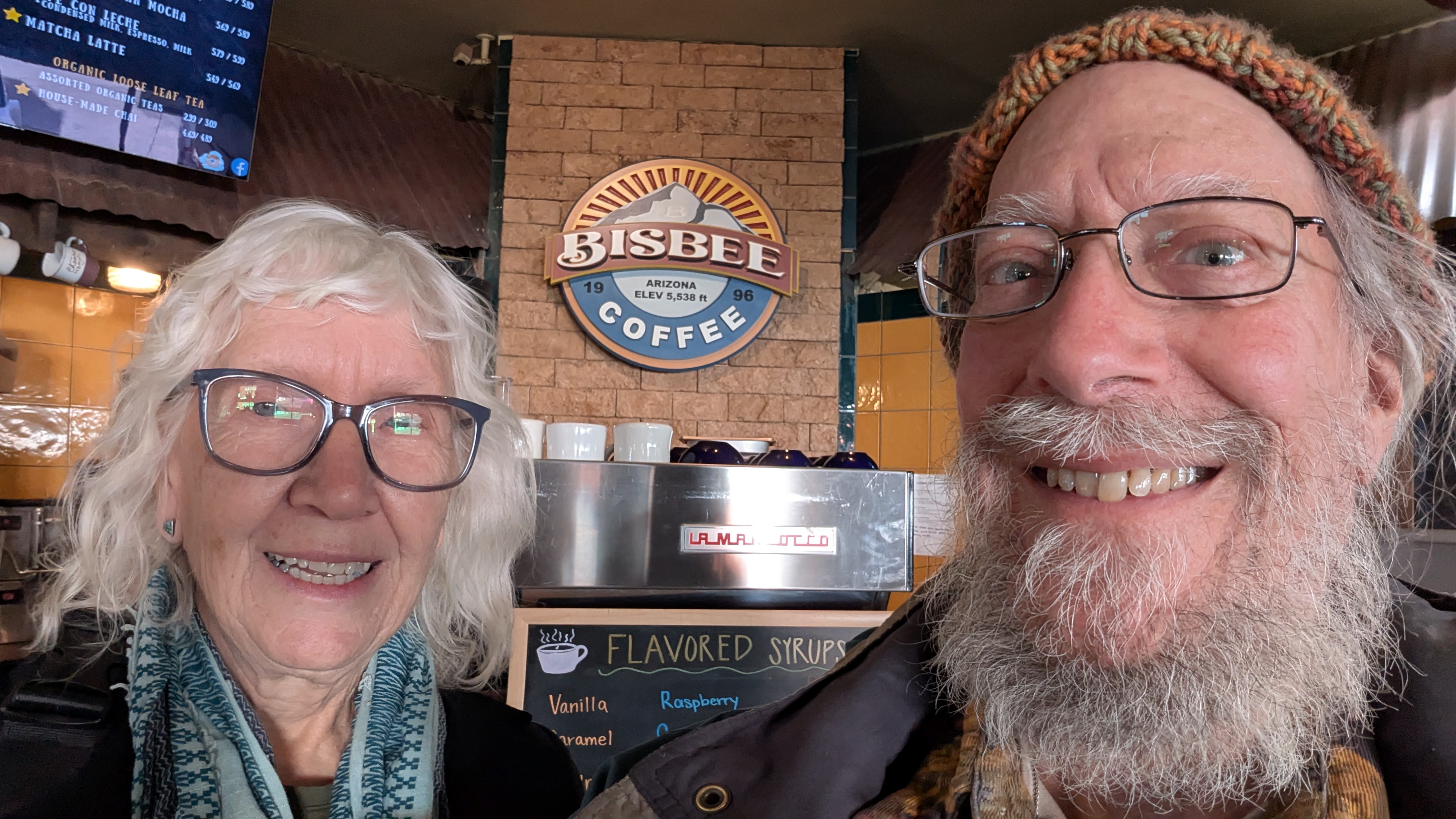
After a brief rest, we headed out again up Tombstone Canyon. Like hobbits, we sought a second breakfast, this time at House Royale, which combines bar, theater, and café. Here Linda found eats more in line with her taste: eggs and potatoes. There I discovered Southern Arizona grits made from corn meal, cheese, and garlic, chased with grapefruit-orange juice.
The gladdened couple gathering our things, stood in line to check out of the Copper Queen, then toured the adjacent Mining and Historical Museum. It outlined the 1883 commencement of the extensive burrowing industries there. At its height in the 1920s, the village and its nearby suburbs held nearly 10,000 people. When the boom busted in the 1960s, artists and hippies moved in. Today, but half of the peak population remains, with heritage tourism the chief economic engine.
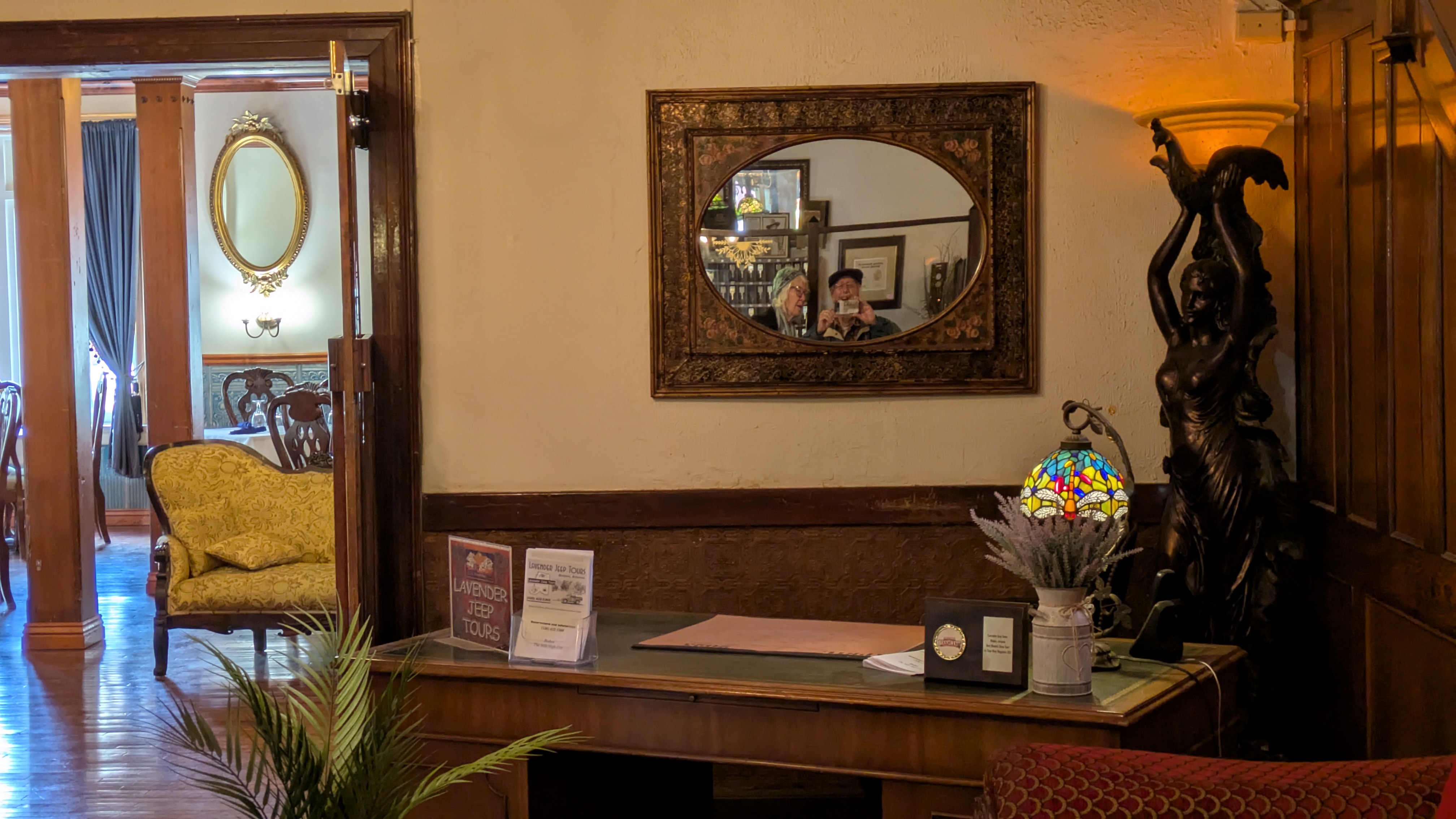
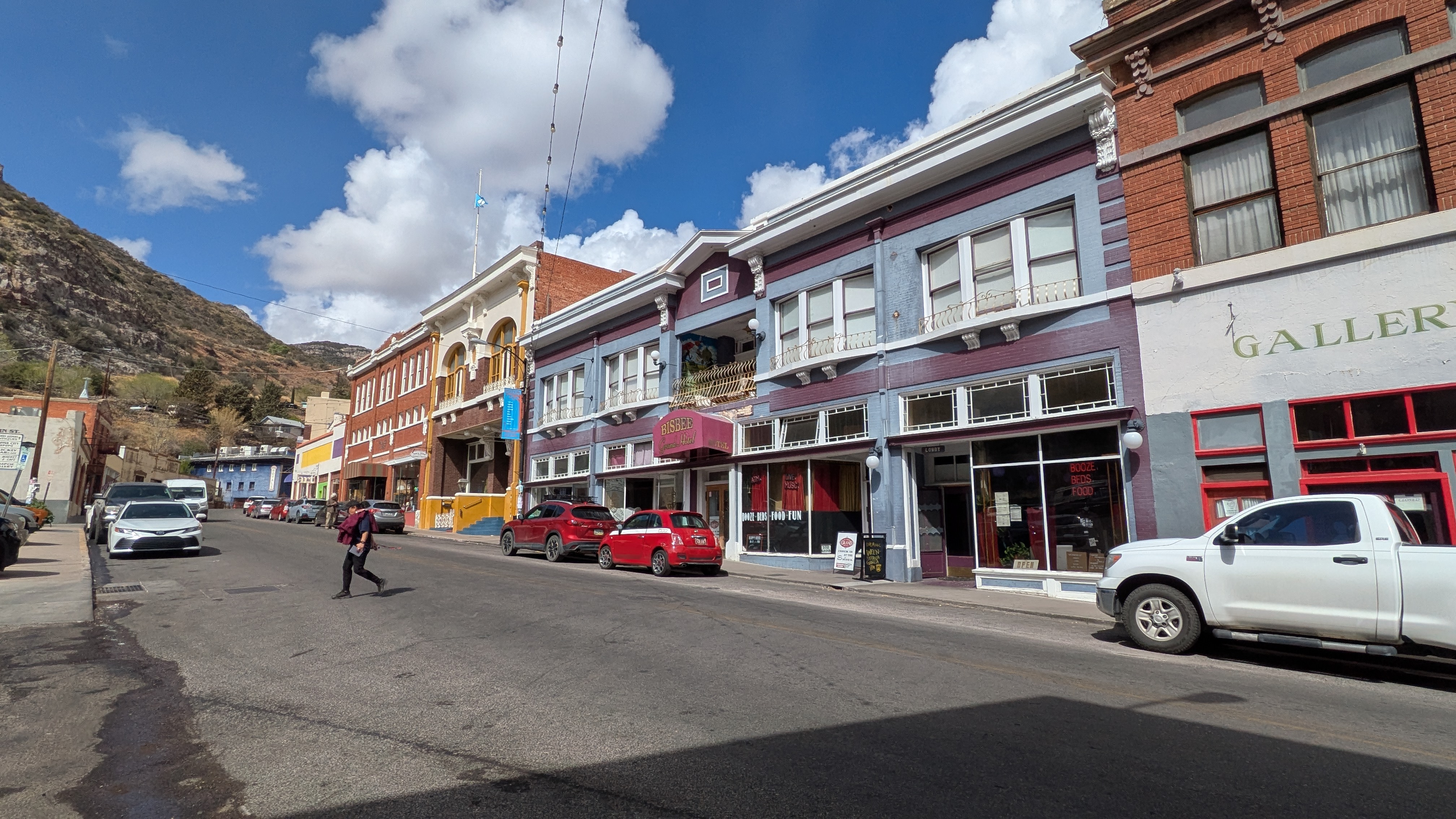

From the city’s center, we drove northwest up the canyon past the iconic Iron Man statue, a larger-than-life metal monument to “those virile copper miners” and their magnificent contributions to local wealth and lore. Diverse buildings line this strip and well-define a shoestring town. At the top of the burg’s west end stands the Mule Pass Tunnel, and above it a marker mistakenly misidentifies the Continental Divide. No, it’s a regional divide that separates the east-draining Mule Pass Gulch from areas that empty west into the San Pedro River. After an about-face, gravity propelled us back downhill in low gear. We could behold the same reference points from an opposite perspective. Last stop on our way out, off to the right, was the 900-foot deep Lavender Pit, so-named for the rock’s color.

Refueled in Douglas. Headed north on US 191 across the relatively moist and fertile Sulphur Springs Valley. Must be haying season. To the west, dark thunderstorms loomed over the Dragoon Mountains, but didn’t approach us. Paused in Sunizona at the Mustang Mall of Cochise Corner for rest and refreshment (pop and pretzels). Turned east on AZ 181, which bore straight towards the Chiricahua Mountains and their wilderness and national forest. Of a sudden, the road veered north to flank those features and tempt us with a lane into the Chiricahua National Monument, known for its hoodoo formations. Wikipedia defines one as a tall, thin spire of rock formed by erosion, and also called a tent rock, fairy chimney, or earth pyramid. We’ll save that destination for another journey. Ditto for Fort Bowie in the Dos Cabezas range. Willcox boasts vineyards and wineries, which sound delish when we can find the time.
Back on good ol’ I-10, we fairly flew to Lordsburg and retraced our previous route, this time taking note of the actual, real Continental Divide near Burrow Peak. Got home by 6:00 Mountain Daylight Time that evening. Foxie the dog rejoiced at our return. Nothing beats sleeping in your own bed.
Happy anniversary to us!